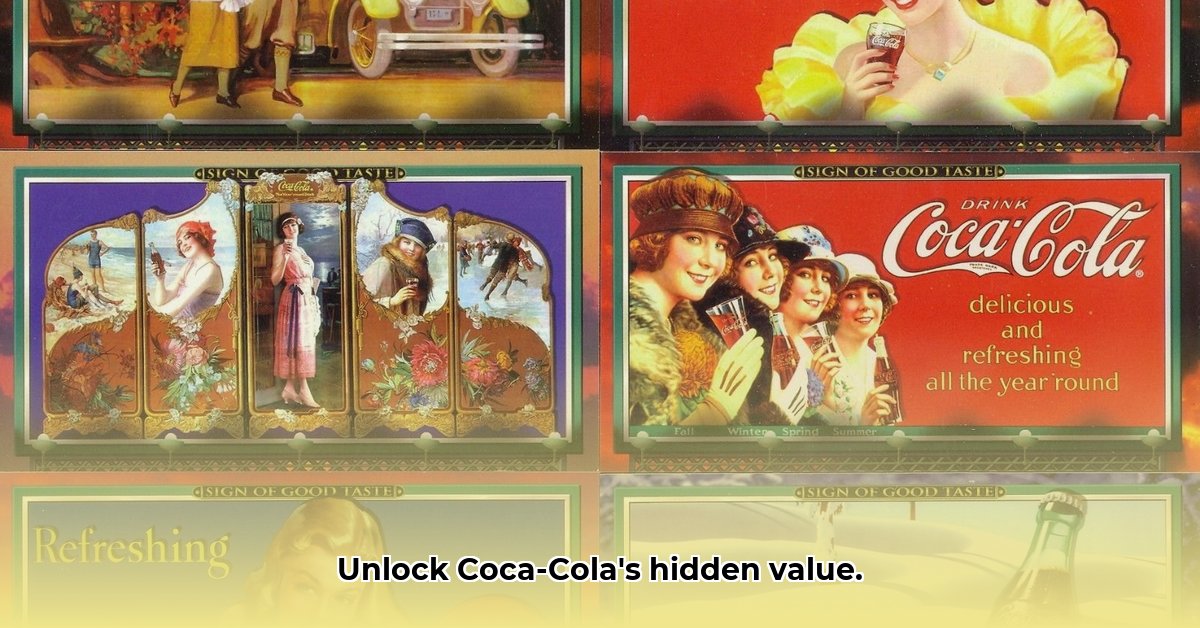
Coca-Cola trading cards aren't just nostalgic trinkets; they're a surprisingly lucrative investment opportunity! This guide unveils the secrets to navigating this exciting market, from identifying valuable cards to building a profitable collection. Let's explore how to turn these pieces of history into rewarding investments.
Understanding the Coca-Cola Trading Card Market
The Coca-Cola trading card market is vast and dynamic, offering both seasoned collectors and newcomers significant potential. Thousands of unique cards exist, each with a story and a price tag influenced by condition and rarity. Sites like eBay showcase the sheer volume of cards traded, indicating strong market demand. However, this also means prices fluctuate wildly. A pristine, early 20th-century card can command significantly more than a common, worn one. But how do you find those hidden treasures?
Unearthing Valuable Cards: Your Step-by-Step Guide
Finding valuable Coca-Cola cards requires a strategic approach. Here's a structured guide:
Master Online Research: Start with online marketplaces like eBay. Analyze completed listings (not just active ones) to understand realistic market prices. This will help you avoid overpaying.
Condition is King: A card's condition dramatically impacts its value. Look for creases, tears, bends, and fading. While professional grading offers definitive assessment, a keen eye for visible damage will suffice for beginners.
Rarity is Your Ally: Some cards are common, while others are extremely rare. Online communities and specialized resources offer insights into card rarity, which often correlates with higher prices. Did you know that certain limited-edition cards are already commanding impressive secondary market prices?
Time is of the Essence: Older cards, particularly those reflecting early Coca-Cola marketing campaigns, often hold greater value due to their historical significance. The evolution of Coca-Cola's branding is directly linked to these cards' worth.
Building Your Collection: Strategies for Success
Building a successful Coca-Cola card collection hinges on a smart approach:
Start Small, Aim Big: Begin with affordable cards to gain experience and understand market dynamics without significant financial risk.
Diversify Your Holdings: A diverse collection, much like a diversified investment portfolio, mitigates risk and maximizes potential returns. Collect cards from various eras and styles.
Patience Pays Off: The market can be volatile. Long-term growth is more reliable than quick profits, and you will avoid rash decisions.
Join the Community: Engage with online forums and communities dedicated to Coca-Cola collectors. Learning from experienced collectors offer invaluable insights and support.
Market Trends and Forecasts: What the Future Holds
Predicting the future is always challenging, but several trends shape the Coca-Cola trading card market:
Nostalgia's Enduring Appeal: Coca-Cola's enduring brand resonates deeply with consumers, driving substantial demand for cards reflecting past campaigns and eras.
Limited Editions Reign Supreme: Modern limited-edition cards frequently become highly sought-after collectibles, boosting their potential for appreciation.
Condition Remains Paramount: Maintaining pristine condition is essential. Even common cards in excellent condition can be surprisingly valuable.
Authenticity is Non-Negotiable: Be wary of counterfeit cards. Research sellers thoroughly and verify authenticity before purchasing.
Actionable Steps to Begin Your Journey
Ready to embark on your Coca-Cola card collecting adventure? Follow these steps:
Define Your Budget: Establish a clear budget that aligns with your financial capabilities and risk tolerance.
Conduct Thorough Research: Utilize reputable resources to research cards, understand their market values and price trends.
Choose Reputable Sellers: Select sellers with positive feedback and reviews to minimize the risk of fraud.
Preserve Your Investment: Store your cards carefully in protective sleeves and albums to maintain optimal condition.
Pros and Cons: A Balanced Perspective
| Advantages | Disadvantages |
|---|---|
| Potential for significant returns | Market volatility and price swings |
| Tangible and visually appealing investment | Demands research and expertise |
| Enjoyable and rewarding hobby | Needs proper storage solutions |
| Supportive and passionate collector community | Risk of encountering counterfeit cards |
| Growing interest in nostalgic items | Requires a considerable time investment |
Disclaimer: This guide provides educational insights and is not financial advice. The Coca-Cola trading card market, like any collectibles market, carries risk. Thorough research and a thoughtful approach are crucial.
How to Determine the Value of Rare Coca-Cola Trading Cards
Determining the value of rare Coca-Cola cards requires understanding key factors:
Rarity: The Ultimate Factor
Rarity directly impacts value. Limited editions are highly coveted, driving up demand and prices. Many early 20th-century cards are exceptionally rare and therefore extraordinarily valuable.
Condition: Preservation is Crucial
A card's condition significantly influences its worth. Even minor blemishes can reduce value substantially, highlighting the value of careful handling and storage. Understanding professional grading scales assists accurate valuation.
Historical Significance: Storytelling Through Cards
Cards reflecting iconic Coca-Cola advertising or historical events tend to command higher prices due to their storytelling potential and historical context.
Market Research: Your Essential Tool
Using online marketplaces like eBay to analyze recently completed sales of similar cards, considering their condition and rarity, provides a solid foundation for estimating value.
Expert Opinions: Seek Professional Guidance
For exceptionally rare or valuable cards, a professional appraisal from a reputable authority is advisable for accurate valuation and authentication.
Steps to Valuing Your Cards
- Assess Condition: Check for damage: scratches, bends, discoloration.
- Identify Rarity: Research production year, design, and special features.
- Research Similar Cards: Compare prices on online marketplaces.
- Consider Historical Context: Research the card's historical significance.
- Seek Expert Appraisal (Optional): Consider expert appraisal for high-value cards.